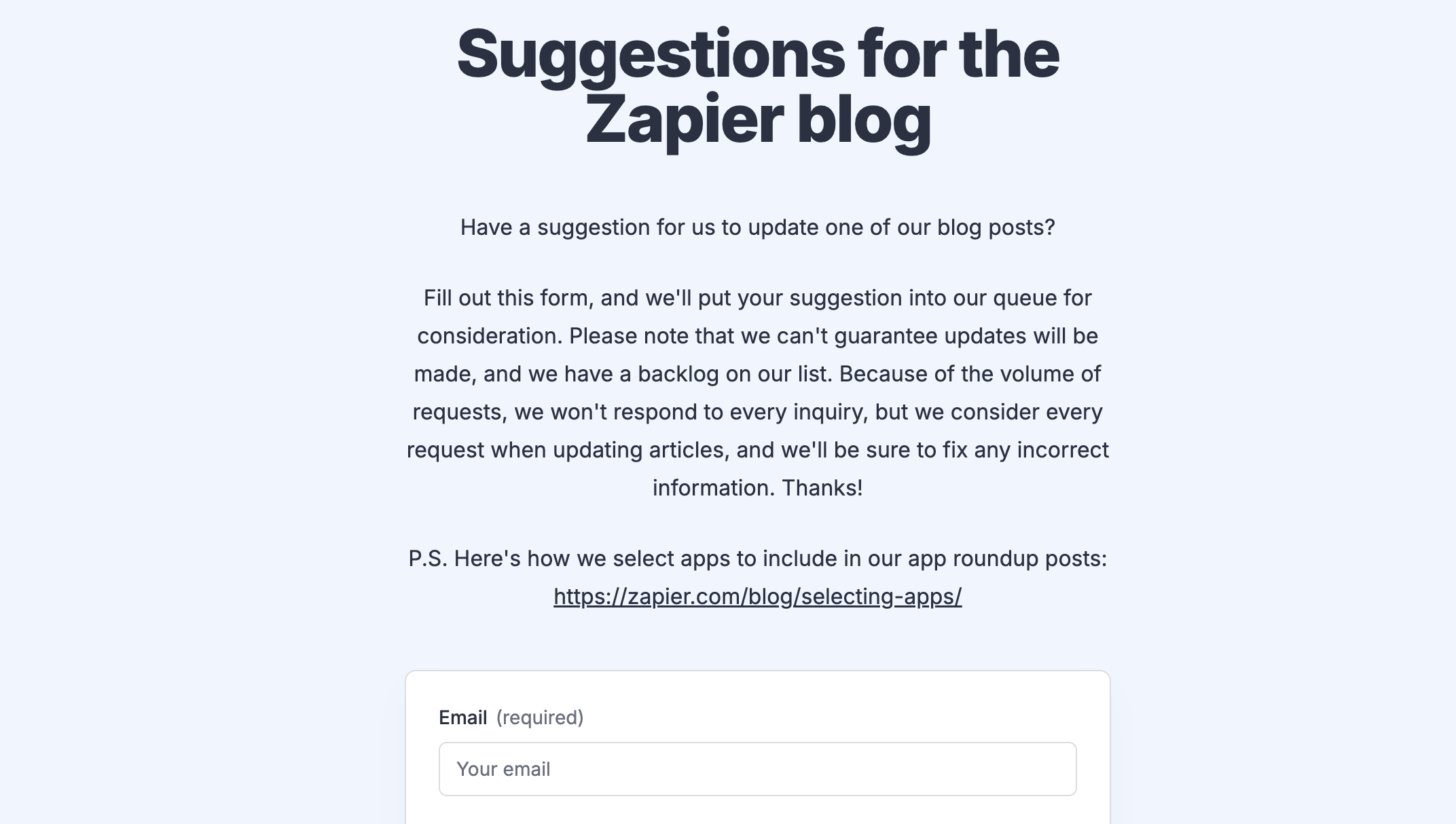The holy grail of today's marketing is getting into LLM recommendations. Randomized studies cite Reddit as one of the most quoted sources for some engines, leading to obsession over gaming Reddit for visibility. But those randomized queries aren't particularly useful for SaaS companies - sources differ dramatically between consumer questions ("best pizza near me") and business recommendations ("best project management software for remote teams").
For specialized queries about business software, we have a different leader. And the leader is... Zapier.
In our recent experiments testing LLM recommendations for SaaS products, Zapier's blog consistently appears alongside Capterra, TechCrunch, and other reputable publications (see our LLMy Awards report here for examples). When someone queries Claude, ChatGPT, or Perplexity about the best tools in virtually any software category, these systems cite Zapier as an authority. They're not pulling recommendations from thin air - they're referencing sources that have earned credibility through comprehensive research and editorial integrity.
This represents the new frontier of software distribution: AEO (Answer Engine Optimization), GEO (Generative Engine Optimization), and NEO (Neural Engine Optimization). Traditional SEO focused on ranking in Google search results. The new game is getting your product recommended when users ask AI systems for solutions—a shift we explore in depth in how B2B software directories shape your AI SEO strategy. And for B2B software, that path runs directly through sources like Zapier's blog.
How Zapier Built AI-Trusted Authority
Zapier is an automation platform that connects different apps - the digital duct tape holding your tech stack together. Their blog strategy is brilliantly aligned with their core business: by comprehensively reviewing and comparing thousands of apps across every category, they've become the authoritative resource for understanding which tools work best and how those tools connect through their platform. It's a masterclass in strategic content marketing that drives both discovery and distribution for the tools they feature.
Hitech veterans may recall Intercom's blog, which at some point became one of the most credible sources of up-to-date knowledge about product management and customer success. Zapier has achieved something similar for software recommendations, but at a much larger scale. While most SaaS blogs churn out recycled listicles and half-baked "thought leadership," Zapier took a different approach. Their secret weapon is obsessive, borderline-fanatical app testing combined with editorial transparency that both humans and AI systems recognize as trustworthy.
Comprehensive testing, not superficial reviews. Before writing The Best Meeting Scheduler Apps, Zapier's team spends dozens of hours actually using meeting schedulers. They create real meetings, test booking flows, evaluate UI, stress-test integrations, and contact support when things break. For internal tool builders, they build actual tools. Everything gets logged in spreadsheets and evaluated against objective criteria they define upfront.
Clear, objective evaluation criteria. For each category, they determine what actually matters to users - whether that's customization for calendar apps or data sources for tool builders. Then they test every app against these benchmarks, explaining their methodology transparently. This structured approach makes their content valuable for AI models seeking authoritative recommendations.
Relentless publishing and updating. Zapier maintains an entire "Best Apps" category with hundreds of comprehensive listicles that get updated regularly. Many articles show recent updates from 2024 and 2025, proving they're constantly refreshing content to maintain accuracy. This living database of software recommendations keeps getting better.
Uncompromising editorial independence. Zapier's team works independently from other stakeholders. They're never paid for placement, even by Zapier partner apps. They don't favor apps their own team uses. This integrity is precisely why LLMs trust them - algorithms can spot paid placements and bias from a mile away.
Millions of monthly views and consistent citations in AI-powered search results followed. When an LLM recommends tools, it cites Zapier because Zapier earned that authority through quality and transparency.
The Smart Move: Zapier Made It Open
Here's where Zapier's strategy gets even smarter. Rather than keeping their listicles as a walled garden, they built an open submission system where companies can propose their products for consideration - Zapier's Blog Suggestions Form.
This openness serves multiple purposes. It ensures comprehensive coverage across categories, surfaces new tools they might have missed, and maintains their commitment to featuring the best apps rather than just the ones that pitch them. But the openness comes with rigorous standards - they've documented their complete evaluation methodology at How We Select Apps, so everyone knows exactly what it takes to get included.
This combination of accessibility and transparency is what makes Zapier's recommendations valuable for both human readers and AI models. They're not gatekeeping, but they're also not including everyone who asks.
What It Takes to Get Included
Zapier's selection process reveals what makes content trustworthy in the AI era. Understanding their criteria helps you navigate their submission system effectively - and improves your broader AEO, GEO, and NEO strategy:
Merit over money. Zapier doesn't accept payment for placement. Your product gets evaluated purely on whether it's actually good at what it does. This is precisely why their content gets cited in AI search results - the recommendations are genuinely credible, not advertorial content dressed up as reviews.
Category fit and clear differentiation. When Zapier reviews a category, they define what features matter most to real users. Your product needs to deliver on those fundamentals. Even excellent apps don't make the list if another product better fills that specific "best for [X]" position. This specificity is what makes their recommendations valuable for GEO and NEO - AI models need clear differentiation between similar tools.
Real-world testing that matters. Their team will actually use your product as regular users would. They'll test your onboarding, explore features, invite teammates, and contact support when things break. Poor user experience, confusing onboarding, or buggy core features will keep you out - not because Zapier is harsh, but because their readers (and AI systems citing them) need reliable recommendations.
Existing evaluation may have happened. Sometimes apps aren't included because Zapier already tested them and found better alternatives. The app universe is huge, and only the genuinely best options make the cut. This rigorous curation is exactly what makes their listicles worth citing.
How to Use Zapier's Submission System
Understanding the process helps you approach it strategically:
The submission form at https://zapier-blog-suggestions.zapier.app/form requires specificity. Explain which article your product fits into and what makes you uniquely valuable. Generic "please include us" submissions get lost. Detailed ones demonstrating understanding of their criteria and your specific "best for [X]" positioning get serious consideration.
Understand their evaluation process at https://zapier.com/blog/selecting-apps/. Here's what matters: Zapier starts by defining what features are essential for each category, then researches comprehensively across industry sources and community feedback. They test every app as a real user would - signing up, using core features, inviting teammates, and contacting support. They're looking for apps with unique strengths that serve specific user needs, not just "good enough" solutions. You don't need to be a Zapier partner to qualify - their editorial team evaluates apps regardless of partnership status or connections. What matters is having a clear "best for [X]" positioning that fills a genuine gap in their coverage. This methodology isn't just useful for Zapier submissions - it's a blueprint for building AEO, GEO, and NEO credibility across all authoritative sources.
Set realistic expectations. Zapier is transparent about their process: they can't guarantee inclusion, they have a backlog, and they won't respond to every submission. Submit once with your best case when your product is genuinely ready for scrutiny, then focus on making your product undeniably good.
Think beyond one channel. Zapier is one powerful source of AI search visibility, but smart distribution strategies target multiple authoritative sources. While pursuing Zapier inclusion, invest in your own SEO, create quality content, engage your community, and pursue other credible directories that AI models reference. Build AEO, GEO, and NEO presence across the entire web.
Why This Matters for Your Distribution Strategy
Zapier's success reveals a fundamental shift in software discovery. Traditional SEO still matters, but increasingly, purchase decisions start with AI-powered queries. Users ask Claude or ChatGPT for recommendations, and these systems cite sources they trust. Zapier earned that trust through comprehensive testing, objective evaluation, and editorial independence.
This is the new distribution game. It's not enough to rank in Google anymore - you need to be recommended when users ask AI for solutions. The path to those recommendations runs through trusted, comprehensive sources like Zapier's blog.
Their approach offers a blueprint: create content so thoroughly researched and objectively valuable that both humans and AI naturally reference it. This is distribution built on substance rather than manipulation. Getting featured in sources like Zapier isn't about gaming the system - it's about building products so good they deserve the recognition.
The submission form is open. The evaluation criteria are public. Your product quality determines the rest. Build something genuinely excellent, understand what makes your solution uniquely valuable, and make your case clearly. That's how you earn visibility in AI-powered recommendations.
 The Zapier blog suggestions form - your gateway to editorial coverage
The Zapier blog suggestions form - your gateway to editorial coverage
FAQ: Answers to Common Questions
Why does Zapier's blog matter for AI recommendations?
Zapier's comprehensive software reviews and listicles have earned trust with both humans and AI systems. When AI models like ChatGPT or Claude recommend software tools, they frequently cite Zapier's blog as an authoritative source. Being featured on Zapier means you're more likely to appear in AI-generated recommendations when users ask for software suggestions.
Does being a Zapier integration partner help with blog inclusion?
No. Zapier's editorial team operates independently from their partnerships team. They evaluate apps purely on merit—whether your product genuinely deserves to be called "best for X" in their category. Having a Zapier integration is useful for users but doesn't influence editorial decisions about blog coverage.
How long does Zapier take to respond to submissions?
Zapier is transparent that they can't respond to every submission and maintain a backlog. Some companies never hear back; others get included months later when relevant listicles are updated. Submit once with your best case, then focus on building the product quality that makes inclusion inevitable rather than following up repeatedly.
What makes a strong "best for X" positioning?
Zapier looks for specific strengths that serve distinct user needs. Generic "we're good at everything" positioning fails. Strong positioning sounds like "best for solo consultants who need fast scheduling without calendar complexity" or "best for enterprises with complex approval workflows." Be specific about who you serve best and why.
Should I submit to Zapier if my product is new?
Wait until your product is genuinely ready for scrutiny. Zapier's team will actually use your product—testing onboarding, exploring features, and contacting support. Poor user experience, buggy core features, or confusing onboarding will hurt your chances. Launch on Product Hunt first, collect early reviews on G2, then approach Zapier when your product is polished.
You May Also Like
If you found this guide helpful, check out these related articles:
- How to Get Your Software Ranked on G2 - Learn G2's scoring algorithm and how to build a sustainable review strategy
- Directory Strategy as Competitive Moat - Build an enduring advantage through systematic directory presence
- How to Get Your First Customers from Your Competitor - Win customers from competitors using G2 reviews
- What is Peerlist and Should Your Startup Be There? - Understanding Peerlist's unique position in the startup ecosystem
- LLMy Awards: The Top 10 AI Writing Assistants - Consensus-based ranking of the best AI writing tools
Use Blastra to submit your business to relevant software directories and manage your listings.

